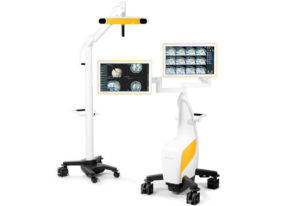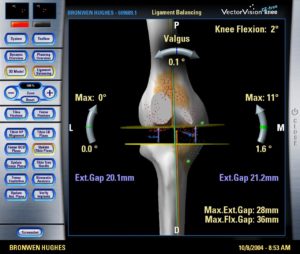Introduction
Computer assisted surgery (CAS) in total knee replacement (TKR) attempts to correct some of the problems faced in traditional TKR. Accurate placement of a knee replacement is one of the most important predictors of longevity of TKR. Minor misalignment can lead to early loosening, early polyethylene(plastic) wear and poor function.
Until the advent of CAS the only way to accurately assess the final position of the implanted prosthesis was with a post-operative x-ray. CAS allows the surgeon to accurately check and adjust, if necessary, each step along the way when performing the knee replacement, whilst still allowing the surgeon to exercise his skill and judgement for optimal positioning of the implant.
How does CAS work?
At the start of the procedure an infrared targeting device is placed above and below the operative field via pins placed through the femur and the tibia. These infrared targets allow the computer to be aware at all times of where the limb and the knee replacement are sitting.

The computer is a free standing tower with a video monitor that stands in the corner of the operating theatre. It can be operated by the surgeon or by an assistant. The video monitor gives immediate feed back through every step of the knee replacement. A standard incision and approach can be performed. However, CAS becomes a great tool when performing mini-invasive surgery (MIS) as well. CAS facilitates MIS extremely well. Certain anatomical landmarks are recorded using an infrared probe and it is these points and their relationship to the previously described infrared targets which allow the computer to create a 3 dimensional model in real time of the knee replacement.
The knee replacement proceeds along the traditional steps of making bony cuts and balancing the soft tissues about the knee. However, CAS allows the surgeon to verify each single step as he progresses and how that will impact on the final result. CAS uses standard TKR implants which have a proven track record. CAS provides a more accurate way to place the standard TKR components that have a proven track record rather than utilising unproven new components. Post-operatively the treatment is unchanged from previous TKR surgery. However, if MIS surgery is used then recovery can be quicker.
Advantages of CAS to the surgeon:
There are now many scientific studies on Computer Assisted surgery in Total Knee Replacement. These studies show better alignment with CAS over traditional knee replacement techniques. It is well understood that long term outcomes of knee replacement surgery are directly linked to how accurately the knee replacement is put in at the time of surgery.
CAS gives much more accurate information throughout the surgery allowing the surgeon to make decisions through the surgery to correct for various issues that arise. Doctor Lawrie has been using CAS routinely for knee replacement surgery since 2005. “I continue to see many situations where CAS system allows me to correct a deformity accurately that would not have been possible without the use of CAS”. Situations such as having a hip replacement above the knee, having a particularly large knee, a large fixed deformity especially the valgus knee (knock knee deformity), soft bone in older patients or inflammatory disease ( rheumatoid arthritis) and patients with previous surgery all are examples where CAS has shown clear advantages over standard techniques.

In these more difficult situations CAS can actually reduce the operating time as the surgeon can be more confident in the decision making at the time of surgery. Almost all studies show that no matter the surgeons experience more accurate results will be achieved with CAS then with standard techniques. It is hoped that better alignment will translate into better long term outcomes for the patient.
Are there any disadvantages to the use of CAS?
As with any new procedure, there is a learning curve involved with CAS. The surgeon is given much more information than previously with traditional TKR. The surgeon needs to take on this information, digest it and use it appropriately, without forgetting the previous lesions learned from traditional TKR. CAS is only a tool to help the surgeon produce a better functioning TKR. Just because a computer is in the room, it does not mean automatically that one will end up with a better knee replacement.
CAS does not do the TKR for the surgeon and it is not taking the decision making away from the surgeon. It allows the surgeon to make more informed decisions throughout the surgery. CAS does take longer than traditional TKR. When a surgeon is starting out, at least an extra 30-45 mins is added to the length of the procedure. This increased time would be most evident in the relatively straight forward TKR, however, when a TKR is more complex then CAS should reduce the time as the surgeon has immediate verification of the steps that he has done which often need repeating when using traditional techniques in complex operations. Doctor Lawrie has been using CAS routinely since 2005. The technique adds 5-10mins to the procedure but produces more accurate alignment at the end of the case so should be very beneficial over time for that extra 5-10mins.
In difficult cases CAS often decreases the operative time due to the more accurate information received. The infrared guides which are placed above and below the TKR are potential sources of complications. A pin needs to be placed in the femur and the tibia and there is the potential for damage to nerves, blood vessels, and/or fracture of the bone from these pins. However, these pins are of quite small calibre and these complications can certainly occur from the technique of performing the TKR itself. Dr Lawrie has not seen a problem with the pins used in CAS surgery.
Skin problems can occur from the small separate incisions made for placement of the pins; however, the TKR wound is much larger than the pin wounds and the wound problems would be more common to occur here than at the pin site. Obviously awound is unavoidable when performing a knee replacement. Once again no problems have been encountered with pin site problems.
Who should have CAS?
It is a reasonable argument that the average osteoarthritic knee, when having a TKR replacement put in by a skilled surgeon, should get a very good result. After all, we have been putting in TKR’s for approximately 40 years now. However, evidence is becoming available that CAS is more accurate than traditional techniques.
A recent study in 2003 by Sparmann compared CAS TKR with conventional techniques in a randomised trial. 120 TKR’s were performed using CAS compared to 120 with traditional instruments. The study demonstrated that surgical navigation had the ability to produce more consistent and predictable results from both the femoral and tibial side and in all planes. It is my view that about 30% of knees would obviously be improved by using CAS over traditional methods.
Patients with
- a total hip replacement above the knee replacement
- a bow tibia or a previous fracture of the femur or tibia
- a valgus alignment of the knee
I believe are currently poorly served by traditional jigs and CAS shows an obvious immediate benefit in simple mechanical alignment of these patients.
When the advantages of mechanical alignment are added to soft tissue balancing range of motion etc., then CAS appears to be a very useful technique for most, if not all, TKR’s. The Future Of CAS: I believe there is a real possibility that CAS will become the technique of choice when performing a TKR in the not too distant future.
There is good evidence that CAS can reliably produce better alignment outcomes than traditional techniques.
CAS is currently being validated for:
- total hip replacement
- revision total knee replacement
- uni-compartmental total knee replacement
- anterior cruciate ligament reconstruction
- trauma situations.
Total hip replacement will be the next big step for CAS. I believe CAS will be very useful in reducing the risk of dislocation post hip replacement and avoiding problems with leg length differences, both of which can be difficult to predict using current techniques.
Download